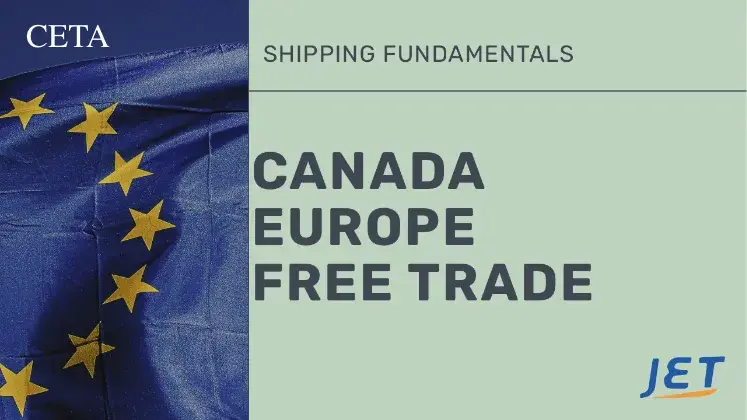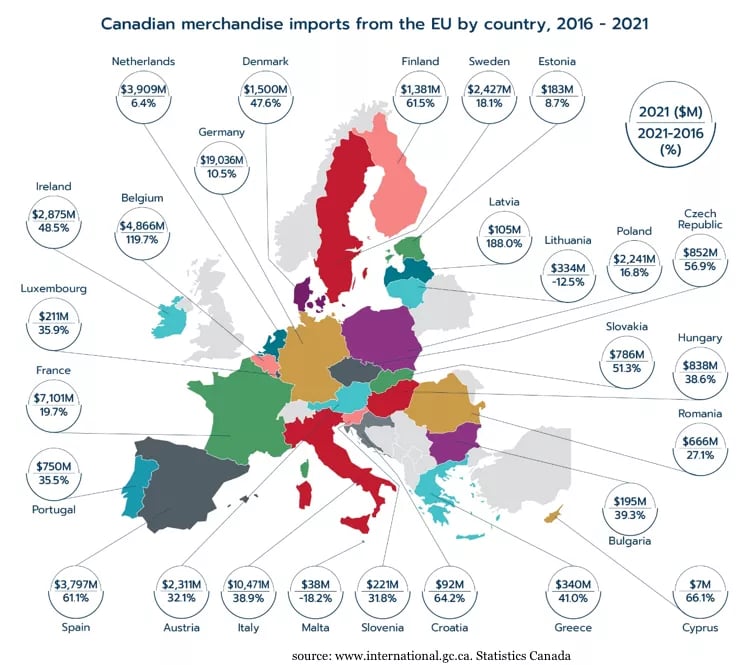
Report Card on Canadian European Free Trade
The European Union (EU) is one of the largest economies in the world and Canada’s second-largest trading partner. The Canada-European Union Comprehensive Economic and Trade Agreement (CETA) has been in force for 5 years. How are things going?
Global Affairs Canada is commemorating the 5 years of CET via the "CETA@5" tag line.
"The CETA@5 Delivering trade benefits during unprecedented times"
Jet Canada has witnessed the benefits of CETA first hand. Freer trade includes more access to European tenders that includes small and medium size companies.

The benefit can accrue also for e-commerce volumes shipped direct from Canada to Europe. Goods that qualify as Canadian origin can clear duty free via simplified clearance IOSS processes.
Useful information regarding a certificate of origin
Advantages of CETA include:
- Increases competitiveness with preferential duty free rates for most goods.
- Access to European government procurement processes.
- More predictable and transparent access to the EU regulatory environment.
- Improved access for service companies
Download accompanying PDF
The expansion in Canadian merchandise exports is most notable to the Netherlands, Germany, Belgium, France, and Spain. Canadian exports to Germany increased by over 35%, since 2016.In addition Canadian exports increased to Eastern European countries including to Latvia, the Czech Republic, Greece, Poland, Bulgaria, and Lithuania.

More Canadian companies trading with Europe
Most interesting is that more Canadian businesses are engaging in trade with the EU. CETA has opened up markets for business across Europe and Canada. Small and medium-sized businesses were the main driver of this growth, expanding to over7,800 companies.
At Jet, we are working with retailers (b to c) and business to business companies to access the European market directly by shipping orders direct. We also help European businesses expand to Canada and across North America.
Read More: Country from where goods were shipped versus country of origin
EORI Number
Companies in the EU are required to have an EORI number if they wish to lodge a customs declaration or an Entry/Exit Summary declaration. Canadian companies should include the importers EORI number on the shipping paperwork
Read more about Canada's Free Trade Agreements.
HS Codes and the The EU classification system
The EU classification system consists of three integrated components.
- The first component is the Harmonized System: chapters (2 digits), headings (4 digits), and subheadings (6 digits).Read about HS Codes.
- he second component is the Combined Nomenclature: EU specific codes via an eight-digit coding system.
- The third component is the Integrated Tariff (Tarif Intégré de la Communauté or TARIC) which provides information on specific tariff measures such as the temporary suspension of duties and antidumping duties.
Canadian businesses are seizing the opportunity to expand their reach into European markets. Shipping goods directly from Canada to Europe has never been easier, thanks to simplified clearance processes for Canadian-origin products.
By facilitating direct shipments and helping businesses navigate the complexities of customs declarations and tariff measures, companies like Jet are empowering Canadian businesses. Engage in trade with Europe with Jet Worldwide resources and expertise.







